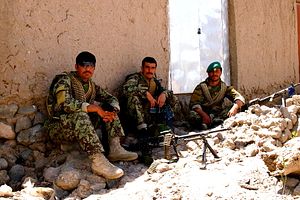This week, the commander of U.S. Forces in Afghanistan, General John F. Campbell, testified in front of the U.S. Senate Armed Services Committee on the still ongoing fighting season in Afghanistan. He offered a somewhat bleaker assessment than during a previous congressional testimony in March of this year (See: “Quo Vadis Afghanistan: General Campbell Testifies on the Hill”).
While noting the Afghan army’s courage and resilience, Campbell said that the recent fighting in Kunduz has illustrated that the Afghan National Defense and Security Forces (ANDSF) “do not possess the necessary combat power and numbers to protect every part of the country.”
Campbell is confident that the ANDSF will regain control of all of Kunduz city. However, he underlined that the overall performance of the ANDSF during this year’s fighting season was “uneven” and “inconsistent,” in particular noting their tendency to remain “tethered to isolated checkpoints and static defenses, which increases their vulnerability and reduces their ability to maneuver effectively.”
The 2015 fighting season has once more shown that the ANDSF still require “broad support” from the United States and its allies. “They have repeatedly shown that without key enablers and competent, operational-level leaders, they cannot handle the fight alone in this stage of their development,” according to Campbell.
Whereas the Afghan Special Security Forces (ASSF) have shown “improved proficiency” this year, the major problem for conventional forces remains an exceedingly high attrition rate, only partially explainable by an accelerated operational tempo (the attrition rate was twice as high in the first nine months of 2015 than 2014).
“Conspicuously, non-battle attrition, particularly unauthorized absences, have induced approximately 70 percent of the ANDSF’s personnel losses. If present rates continue, attrition will pose increasingly significant challenges to force generation, development, and readiness over time,” the general testified.
The capability gaps essentially remain the same as at the beginning of the fighting season and include fixed and rotary-wing aviation, combined arms, intelligence, logistics, maintenance, and sustainment. “One of the greatest tactical challenges for the ANDSF this Fighting Season has been overcoming the Afghan 10 Air Force’s (AAF) still extremely limited organic CAS [close air-support] capability,” Campbell explained.
Campbell also showed great concern over the long-term viability of the ANDSF without long-term U.S. assistance, which covers the majority of the costs:
Succinctly, Afghanistan cannot afford its security forces—particularly at their present size. Yet their current numbers are needed to contend with the scale of the threat. If we sharply reduce their forces now, it will have a detrimental effect. The international community currently funds over 90 percent of the ANDSF’s operating costs. (…) We must assume that that the ANDSF will not be self-sustainable for several years to come.
The top U.S. officer in Afghanistan also issued a dire warning should U.S. troop levels and funding be cut prematurely. “At this stage, without adequate international and U.S. funding support and an appropriate Coalition troop presence to oversee the proper expenditure of such funds, the ANDSF could potentially collapse,” he emphasized.
The general also noted that he has provided the White House with various options that would keep a larger U.S. troop presence in Afghanistan after 2016. President Barack Obama’s initial plan was to reduce troop levels to an embassy-based security force of 1,000.
“Based on conditions on the ground, I do believe we have to provide our senior leadership [with] options different than the current plan we are going with,” he told the senate committee.

































